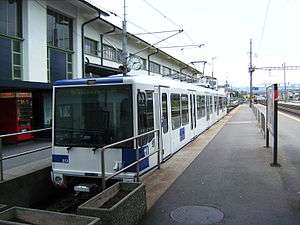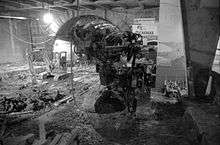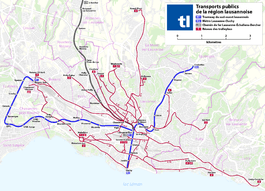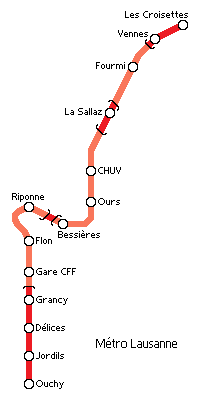Lausanne Metro
 | |||
| Overview | |||
|---|---|---|---|
| Native name | Métro de Lausanne (French) | ||
| Locale | Lausanne, Vaud, Switzerland | ||
| Transit type | Light rail & Rapid transit[Note 1] | ||
| Number of lines | 2 | ||
| Number of stations | 28 | ||
| Annual ridership | 40.8 million (2013)[1] | ||
| Website | Transports Lausannois (TL) (French) | ||
| Operation | |||
| Began operation | 1991 | ||
| Operator(s) | TL | ||
| Technical | |||
| System length |
M1: 7.8 km (4.8 mi)[1] M2: 5.9 km (3.7 mi)[1] 13.7 km (8.5 mi) (Total) | ||
| Track gauge | 1,435 mm (4 ft 8 1⁄2 in) standard gauge | ||
| |||
The Lausanne Metro system is an urban rail transport system in Lausanne, Switzerland, which operates both driverless rapid transit services on a grade-separated route and more traditional light rail services. Around a quarter of the system has been used for urban rail transport since 1877, when the route between the city centre and Ouchy opened as Switzerland's first public funicular railway. The network is owned by two distinct companies and operated by a third.
Of the two operating lines, the first is a limited-capacity light rail route, while the second is a fully automated metro[2] which opened on 27 October 2008. When this opened, Lausanne replaced Rennes as the smallest city in the world to have a full metro system.[3] A third line is now planned, based on the same rubber-tyred metro technology.
History
Former Lausanne-Ouchy line

The Lausanne-Ouchy railway, the precursor to the M2 line of the Lausanne Metro, was inaugurated in 1877 as a funicular. In 1959 the first overhaul took place by transforming the funicular into a rack railway under the name "métro". At that time, Flon and Gare CFF stations were demolished and replaced by concrete underground equivalents. The line was however always nicknamed "La Ficelle" (The String) by its users due to its funicular past and circulation above ground in the greenery for more than half of its run.
Connected to the Flon facilities, the freight trains from the main station to the storage area of the harbour (in Flon) travelled on this line until the construction of a direct connection between the freight station of Sébeillon and the Flon valley in 1954.
The line was finally closed to all traffic on 21 January 2006. The rolling stock was originally sold to the French city of Villard-de-Lans which planned the construction in 2008 of its own rack railway, La Patache, to ensure a link between the center of Villard and Le Balcon de Villard.
A bus service was put into operation to replace the then-closed "La Ficelle" until the opening of the new metro M2 line. This service was called Métrobus (MB): the south loop linked Ouchy to the CFF station and the north loop linked the station to Montbenon (which is located right above the Flon area).
M1 Line
Lausanne originally had a tram system that opened in 1896, and ultimately grew to an approximately 66-kilometre (41 mi) network by 1934. But the original Lausanne tram network closed entirely in 1964.
A modern tramline, which ultimately became Lausanne Métro Line M1, opened on 24 May 1991, and began revenue service on 2 June 1991.[4] In 2001, for marketing and public communication reasons, this line was renamed the M1 line by its operator TSOL. The M1 is a light rail line with a total of 15 stations, a dozen of which are at-grade and three of which are underground.
M2 Line
- Complementary inquiry : September 2001
- Decision by the State Council : June 2002
- Funding requested from the High Council : September 2002
- Popular vote : end 2002
- Duration of construction : 4–5 years
- Metro-Ouchy operations stopped : January 2006
- Official Inauguration : 18–21 September 2008
- In operation from : 27 October 2008
Network
Line M1
| Line M1 | |||
|---|---|---|---|
|
| |||
 Interior of a line M1 train | |||
| Overview | |||
| Type | Light rail | ||
| System | Lausanne Metro | ||
| Locale | Vaud, Switzerland | ||
| Termini |
Lausanne-Flon station Renens railway station | ||
| Stations | 15[1][4] | ||
| Daily ridership | 43,500 (university term-time)[5] | ||
| Ridership | 13.2 million (2013)[1] | ||
| Operation | |||
| Opened | 2 June 1991[4] | ||
| Owner | TSOL | ||
| Operator(s) | TL | ||
| Technical | |||
| Line length | 7.8 km (4.8 mi)[1][4] | ||
| Number of tracks | 1 (some double track sections) | ||
| Track gauge | 1,435 mm (4 ft 8 1⁄2 in) standard gauge | ||
| Electrification | 750 V DC Overhead catenary | ||
| |||
The Lausanne Métro Line M1 was opened to the public on 2 June 1991.[4] The line is owned by a company named TSOL (Tramway du Sud-Ouest lausannois) and this acronym is widely used by the commuters who use the line. Trains on the line are operated by the Transports publics de la région lausannoise (TL, formerly Tramways Lausannois). The M1 is a light rail line with a dozen surface stations and three underground.
The line, which is 7.8-kilometre (4.8 mi) long,[1][4] links the centre of Lausanne, the Lausanne campus (UNIL and EPFL) and Renens. The line is generally single track. At most stations a passing loop is provided to allow trains to pass, and a dedicated platform is provided for each direction. Exceptions to this are Bassenges, UNIL-Sorge and Provence stations, where the line is still single track serving one bidirectional platform.
Rolling stock
Unlike the later line 2, an automated or remotely controlled train was not planned when the line opened in 1991. This may be due to the relatively recent development of automated metro technology, coupled with the decision to develop the line as a light metro with level crossings rather than using grade separation. To run the service, the line was equipped with a set of modern Light Rail Vehicles (LRVs), which run using electricity supplied via an overhead live wire and can be run singly or in multiple units,[6] with each formation needing a driver.
There are a total of 18 of these original LRVs on the line, but after 20 years in service they were showing their age, and 2 were regularly out of use. Additionally, the line has been a victim of its own success, with 12.5 million passengers carried in 2012[6] and the line carrying the equivalent to the entire population of Yverdon-les-Bains every day.[7]
In 2011, the Canton of Vaud gave 34 million Swiss Francs to enable the existing LRVs to have a mid-life refurbishment, and to permit the operator to commission MOB to build 5 brand-new LRVs. Previously, it was physically impossible for all trains to operate with a double formation, but the additional vehicles will enable the line to operate a full double-car service on all 10 peak-hour trains.[4] In order to accommodate the new trains, the depot at Ecublens has been enlarged and additional servicing facilities built.[6]
The first of the new LRVs was finished in July 2013 and was taken to the Ecublens depot in three distinct pieces: one half of the car body, the other half body, and the underframes and bogies. The operator was left to complete final assembly,[6] and the new car entered service in December 2013.[4] It is expected that the full fleet will be in service by 2015, permitting a 5-minute interval service of double-length trains.
Stations
| Station | Altitude | Situation |
|---|---|---|
| Lausanne-Flon | 479m |  |
| Vigie | 481m |  |
| Montelly | 443m |  |
| Provence | 430m | |
| Malley | 422m |  |
| Bourdonnette | 389m |  |
| UNIL-Dorigny | 388m |  |
| UNIL-Mouline | 386m | |
| UNIL-Sorge | 391m | |
| EPFL | 397m |  |
| Bassenges | 399m |  |
| Cerisaie | 398m | |
| Crochy | 403m |  |
| Epenex | 410m | |
| Renens CFF | 404m |  |
Line M2
| Line M2 | |||||||||||||||||||||||||||||||||||||||||||||||||||||||||||||||||||||||||||||||||||||||||||||||||||||||||||||||||||||||||||||||||||||||||||||||||||||||||||||||||
|---|---|---|---|---|---|---|---|---|---|---|---|---|---|---|---|---|---|---|---|---|---|---|---|---|---|---|---|---|---|---|---|---|---|---|---|---|---|---|---|---|---|---|---|---|---|---|---|---|---|---|---|---|---|---|---|---|---|---|---|---|---|---|---|---|---|---|---|---|---|---|---|---|---|---|---|---|---|---|---|---|---|---|---|---|---|---|---|---|---|---|---|---|---|---|---|---|---|---|---|---|---|---|---|---|---|---|---|---|---|---|---|---|---|---|---|---|---|---|---|---|---|---|---|---|---|---|---|---|---|---|---|---|---|---|---|---|---|---|---|---|---|---|---|---|---|---|---|---|---|---|---|---|---|---|---|---|---|---|---|---|---|
|
| |||||||||||||||||||||||||||||||||||||||||||||||||||||||||||||||||||||||||||||||||||||||||||||||||||||||||||||||||||||||||||||||||||||||||||||||||||||||||||||||||
|
| |||||||||||||||||||||||||||||||||||||||||||||||||||||||||||||||||||||||||||||||||||||||||||||||||||||||||||||||||||||||||||||||||||||||||||||||||||||||||||||||||
| Overview | |||||||||||||||||||||||||||||||||||||||||||||||||||||||||||||||||||||||||||||||||||||||||||||||||||||||||||||||||||||||||||||||||||||||||||||||||||||||||||||||||
| Type | Metro | ||||||||||||||||||||||||||||||||||||||||||||||||||||||||||||||||||||||||||||||||||||||||||||||||||||||||||||||||||||||||||||||||||||||||||||||||||||||||||||||||
| System | Lausanne Metro | ||||||||||||||||||||||||||||||||||||||||||||||||||||||||||||||||||||||||||||||||||||||||||||||||||||||||||||||||||||||||||||||||||||||||||||||||||||||||||||||||
| Locale | Vaud, Switzerland | ||||||||||||||||||||||||||||||||||||||||||||||||||||||||||||||||||||||||||||||||||||||||||||||||||||||||||||||||||||||||||||||||||||||||||||||||||||||||||||||||
| Termini |
Ouchy Les Croisettes | ||||||||||||||||||||||||||||||||||||||||||||||||||||||||||||||||||||||||||||||||||||||||||||||||||||||||||||||||||||||||||||||||||||||||||||||||||||||||||||||||
| Stations | 14 | ||||||||||||||||||||||||||||||||||||||||||||||||||||||||||||||||||||||||||||||||||||||||||||||||||||||||||||||||||||||||||||||||||||||||||||||||||||||||||||||||
| Daily ridership | 75,615 (average, 2013) | ||||||||||||||||||||||||||||||||||||||||||||||||||||||||||||||||||||||||||||||||||||||||||||||||||||||||||||||||||||||||||||||||||||||||||||||||||||||||||||||||
| Ridership |
27.6 million (2013)[1] 28 million (2014)[8] | ||||||||||||||||||||||||||||||||||||||||||||||||||||||||||||||||||||||||||||||||||||||||||||||||||||||||||||||||||||||||||||||||||||||||||||||||||||||||||||||||
| Operation | |||||||||||||||||||||||||||||||||||||||||||||||||||||||||||||||||||||||||||||||||||||||||||||||||||||||||||||||||||||||||||||||||||||||||||||||||||||||||||||||||
| Opened | 2008 | ||||||||||||||||||||||||||||||||||||||||||||||||||||||||||||||||||||||||||||||||||||||||||||||||||||||||||||||||||||||||||||||||||||||||||||||||||||||||||||||||
| Operator(s) | TL | ||||||||||||||||||||||||||||||||||||||||||||||||||||||||||||||||||||||||||||||||||||||||||||||||||||||||||||||||||||||||||||||||||||||||||||||||||||||||||||||||
| Rolling stock | 15 2-car MP 89 trains | ||||||||||||||||||||||||||||||||||||||||||||||||||||||||||||||||||||||||||||||||||||||||||||||||||||||||||||||||||||||||||||||||||||||||||||||||||||||||||||||||
| Technical | |||||||||||||||||||||||||||||||||||||||||||||||||||||||||||||||||||||||||||||||||||||||||||||||||||||||||||||||||||||||||||||||||||||||||||||||||||||||||||||||||
| Line length | 5.9 km (3.7 mi)[1] | ||||||||||||||||||||||||||||||||||||||||||||||||||||||||||||||||||||||||||||||||||||||||||||||||||||||||||||||||||||||||||||||||||||||||||||||||||||||||||||||||
| Track gauge |
1,435 mm (4 ft 8 1⁄2 in) standard gauge with running pads for the rubber tired wheels outside of the steel rails | ||||||||||||||||||||||||||||||||||||||||||||||||||||||||||||||||||||||||||||||||||||||||||||||||||||||||||||||||||||||||||||||||||||||||||||||||||||||||||||||||
| |||||||||||||||||||||||||||||||||||||||||||||||||||||||||||||||||||||||||||||||||||||||||||||||||||||||||||||||||||||||||||||||||||||||||||||||||||||||||||||||||

The Lausanne Métro Line M2 is 5.9-kilometre (3.7 mi) long and uses the alignment of the former Lausanne-Ouchy railway, plus a new route towards Epalinges, crossing the whole city of Lausanne from north to south. Construction work (including enabling works) took around 4 years,[9] and brought significant rebuilds of all former Métro Lausanne-Ouchy stations, plus involved moving the platforms at Lausanne-Flon station a short distance further north[2] to give Cross-platform interchange from northbound M2 to the Lausanne-Echallens-Bercher railway. The new line opened in autumn 2008.[9]
Technical
The line is not entirely underground, but the majority (70-90%) of the system is in tunnel.[2][3] The line is steeply sloped, with an average incline of 5.7% and as steep as 12% in some places.[10] A rubber-tyred metro was selected to counter these, the steepest slopes of any similar adhesion-worked system in the world.[2] The constraints in braking distance and deceleration are such that the M2 can travel faster upwards than downwards.

The regular passenger route is 6.5 kilometres (4.0 mi)[10] in length from Ouchy to Epalinges, including 1.5 km (0.93 mi) of line that replaces the former Lausanne-Ouchy railway. There are 14 stations on the line, which makes a 338 m (1,109 ft) vertical gain.[10] An additional 2 kilometres (1.2 mi) of track is contained within the depot at Vennes, along with the signalling, security and information facilities.[2]
The line is entirely automated, managed from a central command station. This means that it is cheaper to operate[2] than a traditional system with drivers, and more flexible during peak hours. The stations are equipped with platform screen doors and dedicated station personnel are on hand to assist passengers. In contrast with line 1, trains also run on a totally separate right-of-way, meaning there is no conflict between the surface traffic and the metro, enhancing safety and reliability compared to a tramway. All new sections of the route were built as double track, plus the reused Lausanne-Ouchy alignment was also rebuilt as double-track, with the exception of the tunnel under the CFF station due to high costs. This leads to increased capacity and less potential for knock-on delays.
Performance
The line opened in 2008 with a designed capacity of 25 million passengers/year, but exceeded this with 27.6 million by 2013,[1] and 28 million in 2014.[8] As of February 2015, overcrowding is now a significant problem, and the state has granted significant funds towards a programme which will improve capacity by running extra trains and building additional tracks.[8]
Trains travel up to every 3 minutes[10] between the main railway station and La Sallaz, with trains every 6 minutes along the rest of the line. The trains travel with a top service speed of 60 km/h (37 mph) top speed,[10] taking 18 minutes to travel the full length of the line. The line was designed for up to 6,600 passengers/hour in each direction.
Stations
The underground stations are located as close as possible to the surface. They are equipped with stairs, lifts and facilities for handicapped people. The Lausanne slopes have been used to create multi-level access, make ramp access easier[2] and take advantage of natural light as much as possible.
|
 Ouchy M2 station, showing a train stabled on a closed platform 'not in use' and another train approaching in the distance. As this station is the end of line the photograph was taken in a way that also shows the track end, including the side guide bars as well as the running pads used by the weight-bearing rubber tired wheels. Photographed through a glass wall. |
|
Rolling stock

- Articulated vehicles with 4 powered bogies.[2]
- 15 two-car trainsets.[2]
- 222 passengers, 62 seated.[2]
- Rubber-tyred metro with lateral guidance based on the MP 89 from Paris Métro.[12]
- Fully automated (Meteor).
Technical data of the trains
- Length of a train : 30,680 mm (100 ft 7.9 in)
- Length of a car : 15,340 mm (50 ft 3.9 in)
- Width of a car : 2,450 mm (8 ft 0.46 in)
- Height of the car to ground level: 3,470 mm (11 ft 4.61 in)
- Mass of an empty train : 57,316 kg (126,360 lb)
- Mass of a train at maximum load (4 p/m²) : 72,856 kg (160,620 lb) (¹)
- Width of the access doors : 1,650 mm (5 ft 4.96 in)
- Height of the access doors : 1,900 mm (6 ft 2.80 in)
(¹) Calculated with an average of 70 kg (154 lb) per passenger.
Capacity of the trains
| Number of passengers/m² | Passengers per train | |
|---|---|---|
| Nominal load | 4 pax/m² | 222[2] |
| Full load | 6 pax/m² | 314 |
| Maximum load | 8 pax/m² | 406 |
Delivery of the trains
The first train was delivered to Lausanne on 2 March 2006[9] and all the other trains were delivered at a rate of two per month. When they arrived, the trains were stored in the CFF storage of Lausanne. Once the métro's depot had been completed, the vehicles were moved to the Vennes facility by the Autumn of 2006.
With the line having been over its design capacity for at least 2 years,[1][8] the state granted funds for 3 additional metro trainsets in February 2015. The vehicles are being built in Valenciennes by Alstom, who also built the original fleet, and are designed to be identical to the existing rolling stock.[13] The new vehicles, which are due to arrive in Lausanne by mid-2017,[13] are an interim solution to raise capacity on the central section of the line. Capacity between Lausanne-gare and Sallaz[8] stations will rise from 5,600 passengers per hour (each way) to 7,000 passengers per hour (each way) when they enter service in the last 3 months[13] of 2017. The longer-term plan, for which funding is now also in place, involves a new double-track tunnel under the railway station.[8]
Accidents
On 23 February 2005, part of the tunnel under construction collapsed under the Saint-Laurent square in the centre of Lausanne. More than 500 m³ of debris (water and earth) fell into the tunnel, forming a huge fifteen metre gap. The area was completely evacuated for a few days and consolidation and geological analysis work started. A large pocket of water had not been noticed during the initial explorations.
Repair work lasted for a few months. The incident fortunately had no major consequence; nobody was in the area of the collapse which had heavily damaged a shopping mall. Part of the budget had been allocated for such risks and the deadline for the construction in December 2008 was not directly affected.
On 27 October 2006, a construction worker died from injuries. He had fallen a few days before on the construction site at the level of the entrance of the University Hospital of Lausanne (CHUV).
On 28 July 2008 a high level manager for Alstom who had responsibility for the security system for the new lines was found hanging in the stairwell at the entrance to the Vennes station of the M2. The 45-year-old French man's death appeared to have been a suicide.[14]
Extensions & Development
New Lausanne-Gare section
The state has granted funds for major development of the Métro system, with plans in place for improvement work until 2025. Development on the M2 line will also provide for the future of a line 3. Capacity improvement is currently limited to the central and northern sections of the line, because the tunnel under the main railway station is only single-track. Funding is now in place to build a new double-track tunnel under the railway station, and relocate the métro station closer to the main-line platforms. This will mean extra capacity is available on the whole line, and will leave the original tunnel and 2006 station available for the planned line 3.[8]
Northward extension
The end station Les Croisettes has been designed to allow a future extension of the line to the north[2] towards Epalinges-Village, or even Le Chalet-à-Gobet.
Future service
Line M3
A line M3 is proposed to serve the new development area of La Blécherette [15] and the west of Lausanne (Malley, Renens Bussigny). Line M3 is planned to use metro technology compatible with the M2 and would be in correspondence with M1, M2 and LEB railway at the station Lausanne-Flon. The press theorised that the M3 could take over the M2 line from Ouchy to Lausanne Gare and a new terminus for the M2 would be established.[16] However, this issue has subsequently been clarified: while new platforms will be built at Lausanne Gare, a second tunnel will be constructed from there to Grancy, underneath the main railway station. Under these proposals, both lines 2 and 3 will share the physical track onwards to Ouchy. This additional tunnel would bring the immediate benefit of allowing more frequent métro services to the railway station.[17] The proposals were put to a referendum in February 2014, and having won public approval in the vote, the work on the new line is projected to start in 2018.[18]
The first stage of construction will be between Lausanne-Chauderon station, Lausanne-Gare and Ouchy, as a total of 47 million Francs have been given to the project by the Federal Council. It is expected the second phase of work, between Chauderon and La Blécherette, will cost a further 72 million francs.[17]
See also
| Wikimedia Commons has media related to Lausanne metro. |
Notes
- ↑ The Lausanne Metro has two lines. Line M1 is light rail, Line M2 is rapid transit.
References
- 1 2 3 4 5 6 7 8 9 10 11 "Chiffres clé 2013" [Key figures 2013] (in French). Transports publics de la région lausannoise (TL). 2013. Retrieved 2014-05-21.
- 1 2 3 4 5 6 7 8 9 10 11 12 "Lausanne Metro m2, Switzerland". Railway-Technology.com. Retrieved 2014-08-19.
- 1 2 "Lausanne Subway Prepares to Handle Passengers". Railway Technology. 28 August 2008. Retrieved 2014-08-19.
- 1 2 3 4 5 6 7 8 "Communiqués de presse - La première nouvelle rame m1 en circulation" [Press Release - The first new train m1 in circulation] (in French). Transports publics de la région lausannoise (TL). 19 December 2013. Retrieved 2014-05-21.
- ↑ "m2 – plus de 100'000 voyageurs en deux jours" (pdf) (in French). Transports publics de la région lausannoise. 29 October 2008. Retrieved 2012-09-22.
- 1 2 3 4 "Communiqués de presse - Transfert de la première nouvelle rame m1" [Press Release - The first new m1 train transferred] (in French). Transports publics de la région lausannoise (TL). 9 July 2013. Retrieved 2014-08-15.
- ↑ "Communiqués de presse - Début de la construction des nouvelles rames m1" [Press Release - Construction starts on new m1 train] (in French). Transports publics de la région lausannoise (TL). 15 November 2012. Retrieved 2014-08-15.
- 1 2 3 4 5 6 7 "Des métros au coeur des transports publics du canton: un plan de développement des m2 et m3" (in French). Canton of Vaud.
- 1 2 3 "Chronologie - Site officiel de la Ville de Lausanne" [Timeline - Official site of the City of Lausanne] (in French). Retrieved 2014-08-19.
- 1 2 3 4 5 "Un réseau performant - Site officiel de la Ville de Lausanne" [A performing network - Official site of the City of Lausanne] (in French). Retrieved 2014-08-19.
- ↑ In 2015, the metro station "Ouchy" was renamed "Ouchy-olympique" to mark the 100th anniversary of the installation of the International Olympic Committee in Lausanne.
- ↑ Lambert, Anthony (2013). Switzerland without a Car (5 ed.). Bradt Travel Guides. p. 258. ISBN 978-1841624471.
- 1 2 3 "Alstom to deliver three additional metros for Lausanne Line M2 by 2017". Railway Technology. Retrieved 28 May 2015.
- ↑ "[Dead link]" (in French). Archived from the original on 27 September 2011.
- ↑ "[Dead link]" (PDF) (in French). 17 January 2008. Archived from the original (pdf) on 9 April 2008.
- ↑ "Le M3, qui passera ici ou par là, cherche encore sa voie" (pdf). 24 heures. 10–11 September 2011. p. 15. Retrieved 2014-05-21.
- 1 2 "Le Conseil fédéral mettra 47 millions dans le M3 lausannois". 24 heures. 26 February 2014. Retrieved 2015-01-30.
- ↑ "M3: l'apport de la Confédération réjouit". 20 minutes. 26 February 2014. Retrieved 2014-08-13.
External links
- Transports Lausannois (TL) (French)
- Lausanne Metro at UrbanRail.net (English)
- Lausanne Métro at public-transport.net (English)
- Une petite recherche sur la compagnie du Lausanne-Ouchy et la gare de Sébeillon, par Julien Sansonnens (French)
- LO - Métro Lausanne-Ouchy (Photos) (French)
- galerie Photos-Trains.ch (photos) (French)


